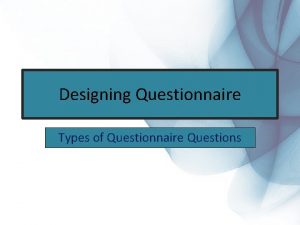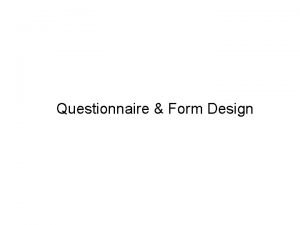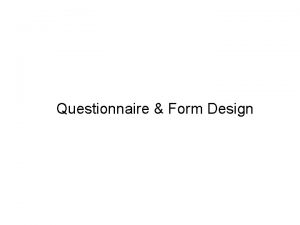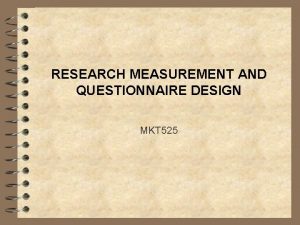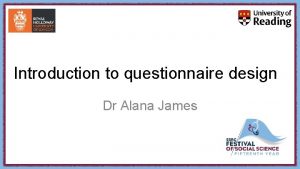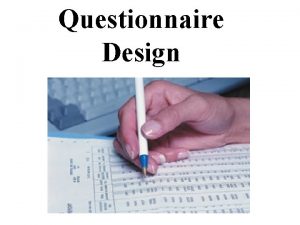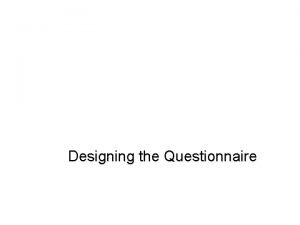Questionnaire Design Lecturer Gianpaolo Vignali Lecture Outline n






















- Slides: 22

Questionnaire Design Lecturer Gianpaolo Vignali

Lecture Outline n n n n Questionnaire objectives Question content Respondent’s inability to answer Respondent’s unwillingness to answer Question structure Question wording Questionnaire layout Question ordering

Questionnaire Objectives n n n Must translate information needed into a set of specific questions that respondents can and will answer Must encourage respondents to cooperate and complete the survey Should minimise response error

Question Content n Is the question necessary? n n Every question should contribute to the information needed or serve a specific purpose Neutral questions can help to establish rapport Filter questions screen potential respondents to ensure that they meet the requirements of the survey Number of questions needed n n Double-barrelled questions can be confusing and result in ambiguous responses i. e. Do you come to this bar for its fast and friendly service?

Inability to Answer n Lack of knowledge n n Limited Memory n n Use filter questions (i. e. product use and past experience) to screen for respondents who are not adequately informed Questions that do not provide cues to the event or that rely on unaided recall can underestimate the actual occurrence of an event Unable to phrase answer n Provide aids such as pictures, maps and descriptions to help respondents articulate their answers

Unwillingness to Answer n Effort required of respondents n n Context n n Unwilling to answer questions that are considered to be inappropriate in a given context Legitimate purpose n n Time, thought, detail Unwilling to provide information that is not seen to serve a legitimate purpose Sensitive information n Unwilling to disclose personal or embarrassing information

Unwillingness to Answer n Techniques to overcome respondents’ unwillingness to answer questions n n n Place sensitive topics at the end of the questionnaire Preface sensitive questions with a statement that suggests that the behaviour of interest is common Ask questions using the third-person technique – phrase the question as if it referred to other people Hide sensitive questions in a group of other questions that respondents are willing to answer Provide response categories rather than asking for specific figures

Question Structure n Unstructured questions Open-ended questions that respondents answer in their own words n Enable respondents to express general attitudes and opinions n BUT, coding of responses is costly and time-consuming n i. e. What is your opinion of Portuguese food? ----------------------------------------------------------------------------------------------------------------n

Question Structured questions n n Questions that specify the set of response alternatives and the response format Multiple choice questions n i. e. Which of the following items have you purchased in the past week from Debenhams? Please tick as many as apply. 1. Clothing 2. Shoes 3. Jewellery … 15. Electrical equipment 16. Other (please specify ______)

Question Structure n Multiple choice questions n i. e. Which of the following items do you purchase most often from Debenhams? Please tick only one answer. 1. Clothing 2. Shoes 3. Jewellery … 15. Electrical equipment 16. Other (please specify ______)

Question Structure n Dichotomous questions n n Allow for only two response alternatives, which are often supplemented by a neutral alternative i. e. Would you hire a school uniform for a hen or stag night? 1. Yes 2. No 3. Don’t know n n The decision to use a dichotomous question should be guided by the complexity of the issue Such questions allow for limited/basic data analysis only

Question Structure n Likert scales n n n A measurement scale with 5 or 7 response categories Responses are given numerical values, which reflect the strength and direction of respondents’ attitudes Many alternative scales, based on what you are trying to measure: n n Agreement Likelihood to purchase Frequency of an activity Importance

Question Structure n Please indicate to what extent you agree or disagree with the following statements: n n n (1) Strongly agree (2) Agree (3) Somewhat Agree (4) Neutral (5) Somewhat Disagree (6) Disagree (7) Strongly Disagree This company is: n n n A very personal place A very dynamic and entrepreneurial place A very formalised and structured place 1 2 3 4 5 6 7 n A very production oriented place 1 2 3 4 5 6 7

Question Structure n Please indicate how likely you are to purchase the following soup flavours: n n n (1) Very Unlikely (2) Unlikely (3) Somewhat Unlikely (4) Neutral (5) Somewhat Likely (6) Likely (7) Very Likely Tomato and basil Wild mushroom Carrot and coriander Leek and potato 1 2 3 4 5 6 7

Question Structure n Please indicate how important the following factors are in influencing your decision to frequent a Portuguese restaurant in Manchester city centre: n n n (1) Not at all important (2) Unimportant (3) Somewhat Unimportant (4) Neutral (5) Somewhat Important (6) Important (7) Very Important Price Quality of food Restaurant atmosphere Location 1 2 3 4 5 6 7

Question Structure n Semantic differential scales n n n A seven-point rating scale The two end points are associated with bipolar labels Similar alternative scales to Likert scales, but only label the two extremes: n n n Agreement Likelihood to purchase Frequency of an activity Importance Can also use more descriptive or attitudinal labels

Question Structure n I would characterise Debenhams as: n n n Old fashioned Modern Low quality Low priced High priced Slow service Dirty 1 2 3 4 5 6 7 High 1 2 3 4 5 6 7 Fast 1 2 3 4 5 6 7 Clean

Question Wording n Clearly define the issue n n n Which brand of shampoo do you use? Which brand/s of shampoo have you personally used at home during the last month? In the case of more than one brand, please list all the brands that apply. Use ordinary words n n Do you think the distribution of soft drinks is adequate? Do you think soft drinks are readily available when you want to buy them?

Question Wording n Use unambiguous words n n n Avoid leading or biasing questions n n n Never, occasionally, usually, often Less than once, 1 or 2 times, 3 or 4 times, more than 4 times Is Colgate your favourite toothpaste? What is your favourite toothpaste brand? Avoid generalisations and estimates n n What is your annual expenditure on groceries? What is the weekly expenditure on groceries in your household?

Questionnaire Layout n n n Provide for questionnaire identification number Make interviewer instructions very clear Routing and order must be clear Separate questions from answers Provide ample space for writing in answers Pre-code as many answers as possible n n i. e. Male (1) Female (2) i. e. Under 18(1) 19 – 25(2) 40 and over(5) 26 – 32(3) 33 - 39(4)

Question Ordering n n n Simple, interesting and non-threatening opening questions Ask about the present before the past Put questions in a logical order Put embarrassing, personal or difficult questions towards the end Beware of order effects where one question may influence the answers to subsequent questions Apart from screening questions, put identification and classification questions at the end of the questionnaire

Summary n n n Be careful when wording questions Use scales whenever possible as these allow for more robust and sophisticated data analysis Use 7 -point scales in preference to 5 -point scales as these provide a greater range of responses (people rarely pick the extreme points on a scale) Pre-code your questionnaire – it will make data analysis and the use of SPSS much simpler and quicker Avoid using too many open-ended questions as these must be coded later or analysed qualitatively
 Lecturer's name
Lecturer's name Gianpaolo carraro
Gianpaolo carraro Gianpaolo parise
Gianpaolo parise Www.foimostre.it
Www.foimostre.it 01:640:244 lecture notes - lecture 15: plat, idah, farad
01:640:244 lecture notes - lecture 15: plat, idah, farad Jeannie watkins
Jeannie watkins Spe distinguished lecturer
Spe distinguished lecturer Hello good afternoon teacher
Hello good afternoon teacher Photography lecturer
Photography lecturer Lecturer in charge
Lecturer in charge Designation lecturer
Designation lecturer Designation of lecturer
Designation of lecturer Why himalayan rivers are pernnial in nature
Why himalayan rivers are pernnial in nature Lecturer name
Lecturer name Pearson lecturer resources
Pearson lecturer resources 140000/120
140000/120 Lector vs lecturer
Lector vs lecturer Lecturer in charge
Lecturer in charge Cfa lecturer handbook
Cfa lecturer handbook Lecturer asad ali
Lecturer asad ali Lecture outline example
Lecture outline example Lecture outline example
Lecture outline example Lecture outline example
Lecture outline example
























